These new digital channels offered marketers something different and the more canny operators realised that, as early adopters, they could significantly reduce their media spend yet still deliver highly targetted messages.
This movement gathered further momentum during the recent financial crisis when swingeing cuts hit marketing departments across the board. But now, with the economic climate finally looking up, companies have started to funnel money back into print, with marketers turning to an unlikely ally to deliver brand communications.
“We are hearing anecdotally that there may be the beginnings of a shift back to traditional media by marketers,” says Two Sides director Martyn Eustace. “A well produced, personalised piece of direct mail, for example, will have a lot more impact than the average marketing email, which is at risk of being immediately deleted and may fall foul of the spam filter.”
Part of the reason for print’s comeback is the emergence of what Eustace calls “digital apathy”.
“Digital media has been used so extensively in recent years that people are overwhelmed,” explains Eustace. “A creative piece of print has the capability to be tactile and stimulate many senses, in a way that can’t be matched by other media.”
Of course the optimum marketing approach is to use the best aspects of print and digital for maximum impact and return.
As Haygarth chief executive Sophie Daranyi points out: “Understanding the needs of your consumers will determine what channels work best for them, be that now or in the future.”
The good news for printers is that print clearly has a significant role to play in the future. Here are some of the most intelligent and creative recent uses of print for marketing.
AUDLEY
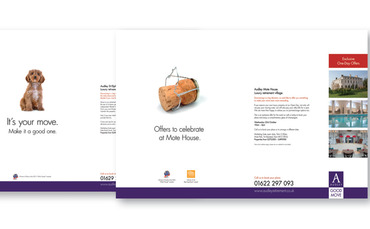 The brief Luxury retirement village operator Audley, which was launched by chief executive Nick Sanderson in the early 1980s, wanted to create a new brand proposition and campaign that would create cut-through in the category and communicate the message that Audley is an “upmarket retirement village that offers total flexibility and independence”. It appointed branding and design agency Haygarth to devise a campaign to “raise awareness and generate response – web visits, phone calls and footfall into the villages”.
The brief Luxury retirement village operator Audley, which was launched by chief executive Nick Sanderson in the early 1980s, wanted to create a new brand proposition and campaign that would create cut-through in the category and communicate the message that Audley is an “upmarket retirement village that offers total flexibility and independence”. It appointed branding and design agency Haygarth to devise a campaign to “raise awareness and generate response – web visits, phone calls and footfall into the villages”.
The solution Haygarth opted for a combination of national press advertising, DM door drops and a brand new website (www.audleyretirement.co.uk), with a twist on the usual approach to marketing of this type of service.
“The campaign moves away from the clichéd images and messaging typically found within the industry and instead, using insight from research, addresses what their customers actually want,” says Haygarth chief executive Sophie Daranyi. “The new campaign uses positive messaging and stand-out images that reflect Audley’s luxury offering.”
The outcome Success. Visitor numbers increased across the company’s villages by 165% and website visits increased by 360% visits, with enquiries from national press advertising more than doubling.
“The campaign has been hugely successful and beaten all targets, with the second round of focus groups describing the new creative as “amazing, exciting, different, clean and vibrant,” says Daranyi.
PRINT POWER
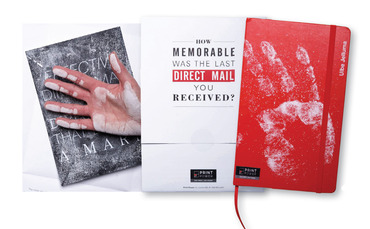 The brief You’d expect an organisation tasked with persuading people of the power of print to come up with something innovative and cutting edge. And Print Power didn’t disappoint in September this year when it launched a new DM campaign.
The brief You’d expect an organisation tasked with persuading people of the power of print to come up with something innovative and cutting edge. And Print Power didn’t disappoint in September this year when it launched a new DM campaign.
The solution To encourage maximum recipient engagement, multi-sensory mailings were sent to 2,200 UK brand owners and media decision-makers. The mailing comprised a poster that was folded up to create an envelope inside of which was a personalised letter, a reply card and envelope, and a chalked blackboard card, which reveals a message when the chalk is wiped away.
Recipients of the mailer were invited to leave a print of their chalk-covered hand on the reply card. They then posted this back to Print Power to receive a personalised Moleskin notebook with their own handprint on the front.
The outcome So far the mailing has gone down a storm. In the UK the mailer received just over a 10% return rate, with replies still coming in (the normal return rate for this kind of mailing is between 0.5%
and 1%).
“Print’s special sensory qualities, particularly touch, just can’t be emulated online and, linked with a well-targeted and imaginative mail campaign, it will deliver impressive results and, importantly, high ROI,” says Martyn Eustace, country manager for Print Power UK.
FOX SPORTS
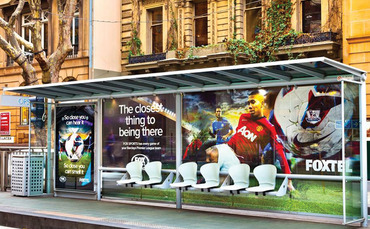 The brief Creating an eye-catching bus shelter campaign is incredibly challenging. Despite having a captive audience – albeit a transient one – passers-by and bus users are often too distracted by other media to notice their surroundings.
The brief Creating an eye-catching bus shelter campaign is incredibly challenging. Despite having a captive audience – albeit a transient one – passers-by and bus users are often too distracted by other media to notice their surroundings.
As a result marketers have to push the boundaries. One of the most successful fully interactive bus shelter campaigns was unveiled earlier this year to promote Fox Sports’ coverage of the new English Premier League in Australia. The company appointed Reed Pacific Media, Mediacom and Foxtel, to devise an engaging outdoor campaign that would stop pedestrains in their tracks.
Doug McNamee, business manager at Reed Pacific Media (Asia) says: “It’s the time of year when English expats [in Australia] are feeling most homesick. With our channel partners we decided that the experience of being at a game would appeal to expats who had missed smelling the fresh cut grass and feeling the atmosphere of the games.”
The solution The team created a newsprint advertising campaign and a bus shelter that featured a large printed poster bearing the slogans ‘the closest thing to being there’ and ‘so close that you can hear it, so close that you can smell it’. The bus shelter included an interactive poster that released the scent of freshly-cut grass and played the sound of cheering fans in a stadium when a button was pushed.
The outcome The campaign offered a complete sensory football experience and attracted media attention on both a local and international level, according to McNamee. He adds: “Print was vital [to the success] as we had both the outdoor print element as well as the newsprint channel. Both allowed us a canvas from which we could communicate the information and also focus on the extra elements of the messaging.”
TODAY'S DESIGNERS
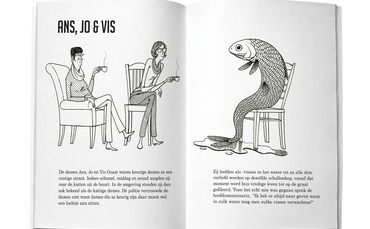 The brief Every year Netherlands-based agency Today Designers challenges itself to come up with a creative publication to showcase its wares – “A statement for looking differently at things and being inspired by nature,” explains Today Designers partner Bob Derksen.
The brief Every year Netherlands-based agency Today Designers challenges itself to come up with a creative publication to showcase its wares – “A statement for looking differently at things and being inspired by nature,” explains Today Designers partner Bob Derksen.
In previous years, the company had printed a book cover using volcanic ash, but this time around the team wanted to print a book of stories about the sea that played on the olfactory senses.
The solution Today Designers hit on the idea of printing a book using squid ink so that the stories would smell like the sea. To start with the team had to establish whether or not it was possible to print using the ink so they visited a local harbour to collect fresh squid ink that was then used to conduct some screen printing tests.
“During the tests we knew that the ink was working and printed the most intense black,” says Derksen. “So we found two excellent writers who were enthusiastic to help us with the nautical tales.”
To intensify the fishy smell the team added a little bit of water and a drop of oil. This combination was used on the book’s cover. Inside the book the squid ink was mixed with a “little bit of printing ink” to aid drying and avoid creating a sticky mess.
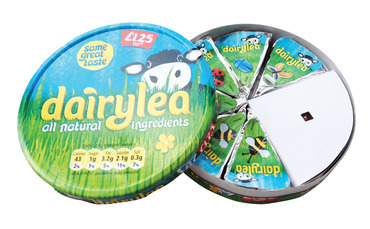 DAIRYLEA
DAIRYLEA
The outcome The book was a resounding success. “It went all over the internet!” says Derksen. “The international design blogs picked it up from New York to Hong Kong, but also a lot of food magazines were interested.”
The brief The cheese brand launched a new all-natural recipe in 2012 and although a fresh outdoor, print and TV campaign had helped to change consumer perception of the product, it was felt Dairylea’s voice on the shop floor hadn’t caught up. So this Easter the company commissioned BMB Neon to create a campaign. The primary objectives were to maximise penetration by 1.5 percentage points, increase the Dairylea Facebook community by 7.5% and improve year on year value and volume sales by 20%.
“As a brand that doesn’t take itself too seriously and is playful in nature, it was obvious we needed to create an innovative mechanic that created theatre and excitement post-purchase,” says Richard Wilcock, account director at BMB Neon.
The solution BMB devised a promotion across multiple channels, including TV, outdoor and social media, but which had opening a pack of Dairylea at its heart.
When opened, Dairylea packs emitted a ‘moo’ to inform shoppers if they’d won a £10,000 holiday. If a shopper didn’t get a winning pack they were directed to the brand’s Facebook page where they stood a chance of winning one of 20,000 Dairylea toy cows that sit in the fridge and moo when the fridge light comes on.
The campaign was supported by a series of motion activated six-sheet posters near supermarkets that mooed at unsuspecting passers-by.
The outcome In addition to hitting the targets that Dairylea set, the campaign was also a viral success, says Wilcock.
“As the promotion built momentum we found that the moo-cows became hugely popular in the social community, with shoppers asking how they could win one beyond usual methods. The chatter on Facebook indicated there was a fear of missing out. The demand for these prizes far outweighed our expectations.”










